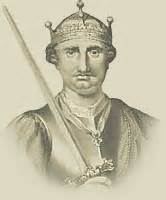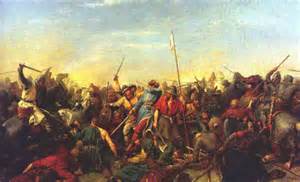The Battle of Stamford Bridge
The Battle of Stamford Bridge was a Saxon victory over invading Norwegian forces in 1066. In the process, however, England's armed forces were depleted enough that they were an easy target for the invading Normans who won the Battle of Hastings. This pivotal battle, which took place in northern England, had its roots in the struggle for the English throne dating back a few generations. King Æthelred II (dubbed "the Unready") was on the throne of England from 978 to 1016. In 1007, he married Emma, the sister of King Richard of Normandy. They had three children together: Alfred, Edward, and Goodwife. Ethelred's death in 1016, in the midst of a Danish invasion, created a void on the throne. Denmark's King Canute filled that void by seizing the throne and marrying Emma as well. Emma had sent her children to Normandy to save them from harm at the hands of the invading Danes. Canute died in 1035, and his son Hardacanute succeeded him. Ethelred's son Alfred died under mysterious circumstances in 1036. Hardacanute then summoned Ethelred's second son, Edward, back from Normandy, naming him heir to the throne. When Hardacanute died in 1042, Edward became king. Edward brought with him a solid understanding of Norman customs and practices (from his time growing up in Normandy and from his Norman mother, Emma) but very little knowledge of English ways of living or speaking. King Edward embraced the religious life and came to be known as Edward the Confessor. His preference for Norman customs, however, didn't set well with many longstanding Saxon nobles. One of the most powerful Englishmen in the country when Edward was crowned was Earl Godwin. Godwin had several sons and one daughter, Edith, who married the king in 1045. Godwin and Edward alternated between working together and opposing each other. A dispute in 1051 resulted in Godwin's exile. With Godwin out of the way, Edward turned to Normandy for an heir. William, Duke of Normandy made a state visit to King Edward's seat of power, and Edward named William heir to the throne. Not long after that, Godwin returned and went about restoring his influence. Godwin died not long after, but his son Harold continued the power consolidation, eventually becoming the most powerful noble in England. Harold regained the trust of Edward, and the king, who was ailing, is said on his deathbed to have promised Harold the throne. In the process of his power consolidation, Harold had had to call in a favor from William of Normandy, and William later claimed that Harold had promised to swear to loyalty to William in his bid for the English throne. When Edward died, in January 1066, Harold pressed his own claim to the throne. The succession wishes of the English king did not constitute a guarantee in those days. England at the time had a ruling council, the Witangamot, that technically named each new English king. After Edward died, the Witangamot named Harold Godwinson king. Hearing this, William set about making plans to take the English throne by force. 
A few months earlier, another of Godwin's sons, Harold's brother Tostig, had made enough trouble in Northumbria to get himself exiled. He promptly fled to Norway and offered his money and connections to Norwegian King Harald Hardrada, a distant relative of Canute. Harald and Tostig joined forces in a big way when Edward died, and Tostig, who in the meantime had taken to harrying English coastal towns, was waiting for Harald's army when the 300 ships carrying about 15,000 men sailed up the Ouse River and marched toward York. English troops under Edwin, Earl of Mercia and Morcar, Earl of Northumbria (Tostig's former position) defended their homeland at the Battle of Fulford on September 20, but the combined forces of Harald and Tostig were too much for the defenders. Following that battle, the city of York offered to surrender. Hearing of this, Harold gathered his housecarls (heavily armed professional troops) and a large number of thegns (the equivalent of landed nobles) and set off north. The army made the trip from London to Yorkshire, 185 miles, in just four days, picking up speed and men along the way. 
Most of the Norwegian troops were back with the ships, awaiting further orders. Flush with victory and enjoying the hot sun of a bright and lazy September day, the 6,000 or so Norwegians who were in and around Yorkshire were unarmored on September 25 and unprepared to defend themselves when Harold and the Saxon army struck. The battle was a wipeout victory for the Saxons. They had a much larger force, and they were fighting an army that was unprepared and unprotected. The Battle of Stamford Bridge, as it was called, involved the Saxons' having to cross a river by seizing control of a bridge that was rather easily defended by a very light force, but even that didn't matter in the end, as the attackers' surprise and overwhelming numbers carried the day. Word of the fighting reached the bulk of the Norwegians anchored off the coast, but their eventual arrival at the battle did nothing to change the course of what then was a devastating rout. Both Harald and Tostig died in the fighting. A victorious Harold had little space to celebrate, however, as on September 28, a mere three days after Stamford Bridge, William and the Normans landed on English soil. |
|
Social Studies for Kids
copyright 2002–2024
David White




